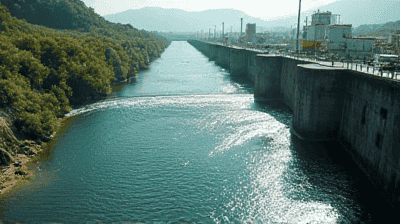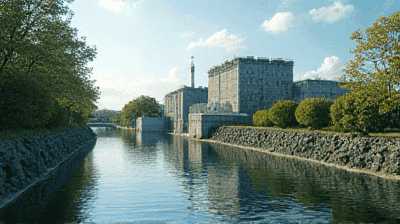
Water is vital for all forms of life on Earth, yet human activities continuously threaten its quality and availability. As we urbanize and industrialize, the risk of pollutants finding their way into rivers, lakes, and oceans increases significantly. Wastewater treatment plants (WWTPs) play a crucial role in mitigating this problem by treating the water that we use and ensuring that it is returned to the environment clean and safe.
Wastewater is water that has been used in homes, industries, farms, and businesses and contains various contaminants, including organic matter, chemicals, nutrients, and pathogens. It can be categorized into several types:
If discharged without proper treatment, wastewater can have devastating effects on aquatic ecosystems and public health:

Wastewater treatment plants are designed to remove contaminants from wastewater before it is released back into the environment. This process typically involves several stages, which can be categorized as primary, secondary, and sometimes tertiary treatment.
Primary Treatment: This initial stage involves the physical separation of larger solids from wastewater through mechanical processes such as screening and sedimentation. The goal is to reduce the amount of suspended solids and organic matter.
Secondary Treatment: This biological process breaks down dissolved organic matter using microorganisms. Aerobic bacteria consume organic pollutants in aeration tanks, while anaerobic bacteria in a digester process sludge, further reducing pollutant levels. Secondary treatment effectively removes a significant percentage of biochemical oxygen demand (BOD) and suspended solids.
Tertiary Treatment: This advanced treatment stage targets specific contaminants that remain after primary and secondary processing. Techniques such as filtration, chemical treatment, and nutrient removal are used to eliminate remaining pollutants, pathogens, and nutrients, ensuring that the treated water meets regulatory standards before discharge.
Over the years, various treatment technologies have been developed to enhance the effectiveness and efficiency of wastewater treatment:
Activated Sludge Process: A widely used method where microorganisms digest organic matter in aeration tanks, followed by sedimentation to separate treated water and sludge.
Membrane Bioreactors (MBR): Combining biological treatment and membrane filtration, MBRs produce high-quality effluent that is free from suspended solids and pathogens.
Constructed Wetlands: This natural treatment approach uses vegetation, soils, and microorganisms to filter and break down contaminants in a more sustainable and environmentally friendly manner.
Advanced Oxidation Processes (AOPs): These methods use chemical reactions to break down complex organic molecules and eliminate pathogens.
Biological Nutrient Removal (BNR): This specialized process focuses on removing nitrogen and phosphorus through biological mechanisms, preventing nutrient pollution in receiving waters.
One of the primary functions of wastewater treatment plants is to protect the quality of rivers, lakes, and oceans. By treating wastewater before it is discharged, WWTPs help to reduce the levels of harmful substances, thereby preserving aquatic ecosystems and preventing degradation of water resources.
Untreated or poorly treated wastewater can lead to serious public health risks. By efficiently treating wastewater, WWTPs safeguard communities from waterborne diseases and pathogens that can spread through contaminated water sources. Clean water is essential for drinking, recreation, and overall public health and safety.
Healthy aquatic ecosystems are critical for biodiversity and the ecological balance of habitats. By preventing pollutants from entering waterways, WWTPs help to maintain healthy ecosystems, support local wildlife, and preserve the natural beauty of rivers and oceans.
As urban areas continue to grow, so too does the amount of wastewater generated. Wastewater treatment plants are essential in managing this increased load, ensuring that urban expansion does not come at the cost of water quality. Effective treatment processes help communities thrive while minimizing environmental impacts.
WWTPs are increasingly becoming important in enhancing climate resilience. By treating and recycling wastewater, these facilities can alleviate pressure on freshwater resources, adapting to climate variability while supporting local water needs.

Many WWTPs around the world are aging and require significant upgrades to maintain efficiency. Untreated or inadequately treated wastewater from outdated facilities can pose a significant threat to water quality. Investing in modernizing infrastructure is crucial for effective water management.
WWTPs are subject to strict regulations governing effluent quality. Meeting these standards requires continuous monitoring, advanced treatment techniques, and sufficient funding. Non-compliance can lead to legal penalties and environmental harm.
Climate change poses challenges such as increased storm intensity, rising sea levels, and changes in rainfall patterns. These factors can compromise WWTP operations, leading to flooding, increased inflow and infiltration of stormwater, and operational disruptions.
Increasingly, WWTPs are tasked with not only treating wastewater but also recovering valuable resources, such as nutrients and biogas. Balancing resource recovery with traditional treatment processes requires innovation and investment in new technologies.
As the need for advanced wastewater treatment solutions grows, several innovative technologies are being developed:
Smart Water Management: Integrating real-time monitoring and data analytics into WWTP operations can enhance efficiency, reduce energy consumption, and improve decision-making.
Microbial Fuel Cells (MFCs): This technology uses bacteria to generate electricity while treating wastewater, presenting an exciting avenue for energy recovery.
Nutrient Recovery Systems: Technologies that capture and recycle nitrogen and phosphorus can help minimize nutrient contamination in water bodies and produce valuable fertilizers.
Decentralized Treatment Systems: Smaller-scale treatment plants or on-site solutions can complement centralized systems, providing flexibility and reducing the burden on existing infrastructure.
Increasing awareness of the importance of wastewater treatment and water conservation can foster community support for local WWTPs. Educational programs can empower individuals to take action in reducing water pollution and conserving resources.
Governments and organizations play a vital role in promoting investment in wastewater treatment infrastructure and research initiatives. Supportive policies can incentivize innovation and facilitate the transition to more sustainable treatment practices.

The Lake Mead Water Treatment Facility utilizes advanced biological treatment processes to ensure clean drinking water and protect the Colorado River. With the rise in demand for water in the region, this facility has implemented state-of-the-art technology to monitor and treat wastewater, significantly improving water quality.
The Pusan WWTP employs a combination of advanced treatment technologies, including constructed wetlands and biological treatment, to reduce pollution levels in the Nakdong River. The facility has made significant strides in restoring aquatic habitats and improving the river’s health, showing how integrated approaches can lead to better outcomes.
Incorporating both conventional and innovative treatment technologies, this university-operated facility is dedicated to research and development. By actively engaging with students and the community, the facility plays a critical role in both treating wastewater and educating the public about the importance of water quality management.
Wastewater treatment plants are essential in the fight against river and ocean pollution. By effectively treating and managing wastewater, these facilities protect water quality, support public health, and preserve aquatic ecosystems. Despite challenges such as aging infrastructure and climate change, innovations and community engagement are paving the way for more sustainable and resilient wastewater treatment practices.
As we continue to face environmental challenges, enhancing the capabilities of wastewater treatment plants will be crucial to ensuring clean, healthy waterways for future generations. By investing in these systems and adopting innovative technologies, we can work towards a more sustainable future, safeguarding our most precious resource: water.